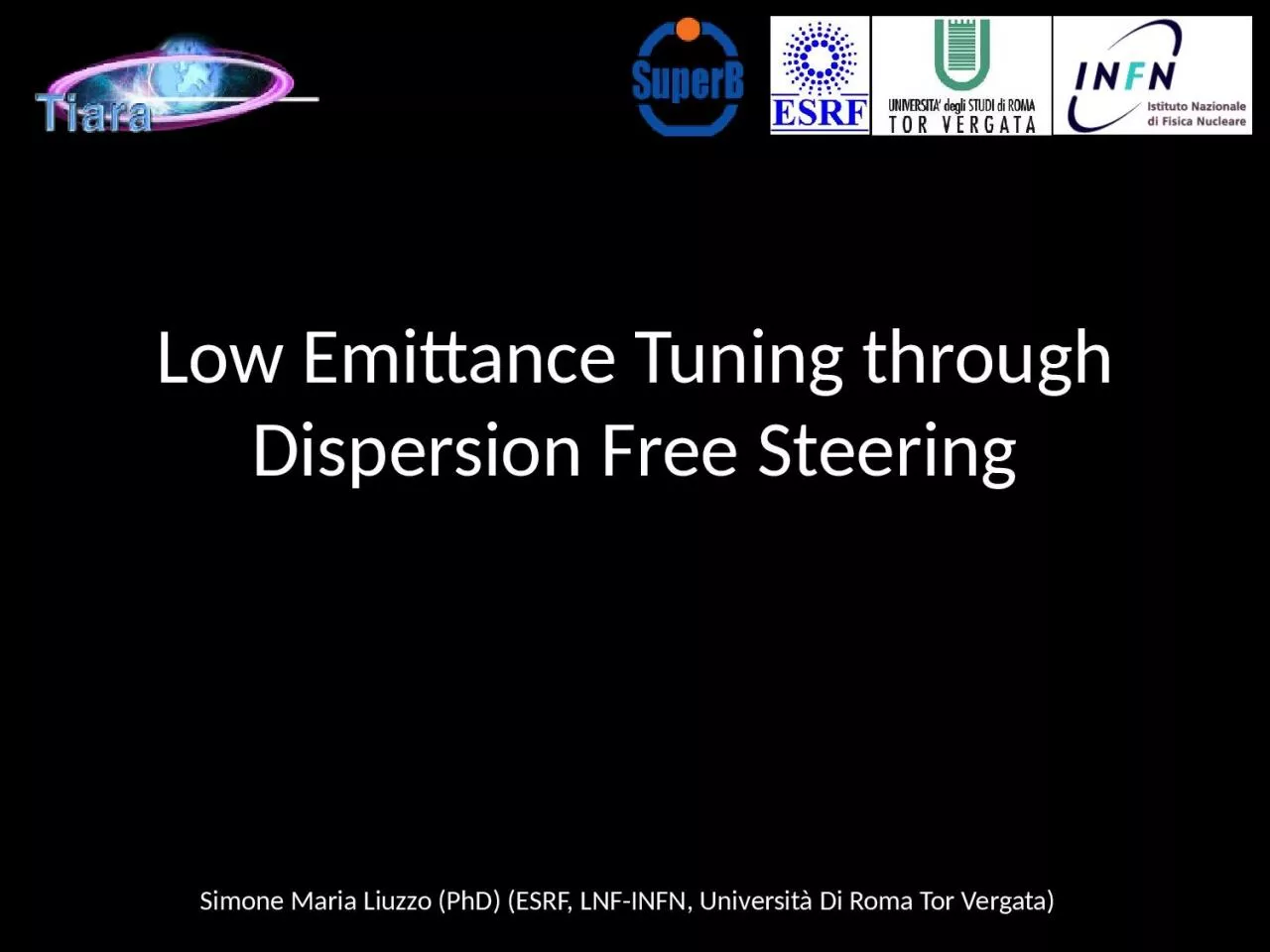

Simone Maria Liuzzo PhD ESRF LNF INFN Università Di Roma Tor Vergata Response Matrix M BPM H Steerers H BPM V Steerers V Orbit correction SVD of M to calculate Correction ID: 1022481
Download Presentation The PPT/PDF document "Low Emittance Tuning through Dispersion ..." is the property of its rightful owner. Permission is granted to download and print the materials on this web site for personal, non-commercial use only, and to display it on your personal computer provided you do not modify the materials and that you retain all copyright notices contained in the materials. By downloading content from our website, you accept the terms of this agreement.
1. Low Emittance Tuning through Dispersion Free SteeringSimone Maria Liuzzo (PhD) (ESRF, LNF-INFN, Università Di Roma Tor Vergata)
2. Response Matrix MBPM HSteerers HBPM VSteerers VOrbit correctionSVD of M to calculate Correction Dispersion response matrix(deviation from reference)Reshapeto a vectorSame forResponse matrixMainly determined by sextupoles
3. CORRECTORS USEDV steerers Skew quad gradientsBpm Roll (Gains in progress) H SteerersBpm RollMatrix M simulated from Model without errorsSVD inversion for simultaneous minimization of dispersion coupling and β-beatingDeviation from reference off diagonal block of the ORM reshaped to be a vectorDeviation from reference diagonal block of the ORM reshaped to be a vectorLow Emittance Tuning TechniqueS.M.Liuzzo PhD[Slide 3]Off axis orbit in quadrupoles and sextupoles used as correctorsNj may be only 1 corrector
4. Coupling estimated from lifetime:εy =1.7 10-12 m rad 350 μm (LOCO:700 μm) Vertical dispersion [m]Lifetime [h]Coupling from Lifetime [h]Residual Vertical orbitLETLET REDLOCO BLUE32 μm (LOCO: 1 μm) 5.5 h5.9 h0.06 %0.07 %Measurements at Diamond (UK)Skew quadrupole Correctors onlyS.M.Liuzzo PhD[Slide 4]Curtesy R.Bartolini
5. Measurements at SLSS.M.Liuzzo PhD[Slide 5]Measurements aimed to achieve low vertical emittance in the TIARA frameworkSame Tool used for Diamond, modified for direct access to Control SystemSWISS LIGHT SOURCE2.411 GeV, 288m, 12 beamlines, 400 mA, 5.4 nm Hor. Emit.Vertical beam size measurements performed using vertically polarized Shynchrotron Light MonitorTUPB27 Proceedings of DIPAC 2007, Venice, Italy
6. SLS measurementsS.M.Liuzzo PhD [Slide 6]Vertical steerers onlysy from 16 mm to 7 mm Before correctionAfter correction
7. SLS measurementsS.M.Liuzzo PhD [Slide 7]Skew Quadrupoles onlyεy =1.6 10-12 m radsy=4.7 ± 0.7 mmBefore correctionAfter correction
8. BPM ROLL error estimation[Slide 8]Ex. For dispersion:Comparable to the previous BPM roll estimates measured at SLSEvaluated simultaneously to the correction set evaluationCourtesy Michael Boge (PSI-SLS)
9. SLS measurementsS.M.Liuzzo PhD[Slide 9]Skew Quad followed by vertical correctors and bpm roll estimationsεy =1.3 10-12 m radsy=4.4 ± 0.9 mm Before correctionAfter correction
10. ESRFVarious vertical beam size monitors, 2 pinhole monitors and 11 In-Air-X-Ray- projection monitors6.03 GeV844 m200mA992 bounchesex=4 nm radey=4 pm radCoupling feedback system using skew quadrupolesMeasurements at the in air x-ray monitors
11. Simulated Comparison with RDTComparison of the methods using RDT calculations on simulated distorted lattice.Starting from the same set of errors we calculate a correction set and evaluate the resiudual RDT. A.Franchi
12. Tests of the ToolObserved 80% UncorrectedPredictedVERTICAL DISPERSIONVERTICAL ORBITCorrection with skew quad and vertical correctors, applied 80%The tool does what it predicts!
13. Skew Correction Starting from zero setBeam size reduction applying skew quad. correction only.New measurement. Further improvements with various correction settings11.8 pm11.8 pmFirst correctionCorrection iteration7.7 pm7.1 pm
14. Horizontal SteerersCorrection of horizontal dispersion and beta-beating using horizontal steerers only
15. Horizontal SteerersCorrection of horizontal dispersion and beta-beating using horizontal steerers only3.3 nmrad3.15 nmrad2.95 nmrad2.7 nmrad
16. Beam Position Monitor Roll estimationsRoll errors may be estimated from all the measurements taken.Not used for the correction
17. ConclusionsLow emittance technique that exploits the off axis orbit in sextupoles and quadrupoles is tested at Diamond, at SLS and at ESRF:Releasing the vertical orbit constraint to reduce dispersion and coupling allows reduction of vertical beam sizeSkew quadrupole correction reach beam sizes and emittance comparable to previously obtained results at SLS (using skew quadrupoles) and at ESRF (using RDT)Vertical steering including the evaluation of psudo-bpm roll errors allows further improvement in the correctionHorizontal dispersion and Beta-Beating correction leads to an improvement in Horizontal emittanceS.M.Liuzzo PhD[Slide 17]
18. Future steps Include Quadrupoles correctors, steerers tilts and BPM gain errors in the correction parameters.Human readable quantities (coupling and beta functions) More measurementsIntroduce the possibility to exclude a region from the correction (ID’s, IP’s).S.M.Liuzzo PhD[Slide 18]
19. Backup
20. Cij and Bij mainly determined by sextupoles (corrector 1 (j=1))
21. Minimum observed vertical dispersion AT ESRF during May-8-2012 MDT2 iterations of correction with skew quadrupoles lead to 810 micron vertical dispersion.